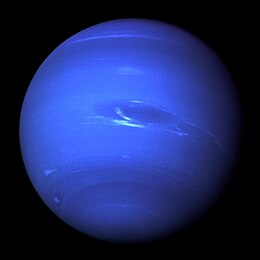Neptune

The picture shows the Great Dark Spot and its companion bright smudge; on the west limb the fast moving bright feature called Scooter and the little dark spot are visible.
|
|||||||||||||
| Discovery | |||||||||||||
|---|---|---|---|---|---|---|---|---|---|---|---|---|---|
| Discovery date | 23 September 1846 | ||||||||||||
| Designations | |||||||||||||
| Pronunciation |
/ˈnɛptjuːn/ |
||||||||||||
| Adjectives | Neptunian | ||||||||||||
| Orbital characteristics | |||||||||||||
| Epoch J2000 | |||||||||||||
| Aphelion |
30.33 AU (4,540 Gm) |
||||||||||||
| Perihelion |
29.81 AU (4,460 Gm) |
||||||||||||
|
30.110387 AU (4,504.45 Gm) |
|||||||||||||
| Eccentricity | 0.009456 | ||||||||||||
| 164.8 yr 60,182 d 89,666 Neptunian solar days |
|||||||||||||
| 367.49 days | |||||||||||||
|
Average orbital speed
|
5.43 km/s | ||||||||||||
| 256.228° | |||||||||||||
| Inclination |
1.767975° to ecliptic 6.43° to Sun's equator 0.72° to invariable plane |
||||||||||||
| 131.784° | |||||||||||||
| 276.336° | |||||||||||||
| Known satellites | 14 | ||||||||||||
| Physical characteristics | |||||||||||||
|
Mean radius
|
24,622±19 km | ||||||||||||
|
Equatorial radius
|
24,764±15 km 3.883 Earths |
||||||||||||
|
Polar radius
|
24,341±30 km 3.829 Earths |
||||||||||||
| Flattening | 0.0171±0.0013 | ||||||||||||
|
7.6183×109 km2 14.98 Earths |
|||||||||||||
| Volume |
6.254×1013 km3 57.74 Earths |
||||||||||||
| Mass |
1.0243×1026 kg 17.147 Earths 5.15×10−5 Suns |
||||||||||||
|
Mean density
|
1.638 g/cm3 | ||||||||||||
| 11.15 m/s2 1.14 g |
|||||||||||||
| 0.23 (estimate) | |||||||||||||
| 23.5 km/s | |||||||||||||
|
Sidereal rotation period
|
0.6713 day 16 h 6 min 36 s |
||||||||||||
|
Equatorial rotation velocity
|
2.68 km/s 9,660 km/h |
||||||||||||
| 28.32° (to orbit) | |||||||||||||
|
North pole right ascension
|
19h 57m 20s 299.3° |
||||||||||||
|
North pole declination
|
42.950° | ||||||||||||
| Albedo |
0.290 (bond) |
||||||||||||
|
|||||||||||||
| 8.02 to 7.78 | |||||||||||||
| 2.2–2.4″ | |||||||||||||
| Atmosphere | |||||||||||||
| 19.7 ± 0.6 km | |||||||||||||
| Composition by volume |
|
||||||||||||
0.290 (bond)
Gases:
80 ± 3.2% hydrogen (H2)
19 ± 3.2% helium (He)
1.5 ± 0.5% methane (CH4)
~0.019% hydrogen deuteride (HD)
~0.00015% ethane (C2H6)
Ices:
ammonia (NH3)
water (H2O)
ammonium hydrosulfide (NH4SH)
Neptune is the eighth and farthest known planet from the Sun in the Solar System. In the Solar System, it is the fourth-largest planet by diameter, the third-most-massive planet, and the densest giant planet. Neptune is 17 times the mass of Earth and is slightly more massive than its near-twin Uranus, which is 15 times the mass of Earth and slightly larger than Neptune. Neptune orbits the Sun once every 164.8 years at an average distance of 30.1 astronomical units (4.50×109 km). It is named after the Roman god of the sea and has the astronomical symbol ♆, a stylised version of the god Neptune's trident.
Neptune is not visible to the unaided eye and is the only planet in the Solar System found by mathematical prediction rather than by empirical observation. Unexpected changes in the orbit of Uranus led Alexis Bouvard to deduce that its orbit was subject to gravitational perturbation by an unknown planet. Neptune was subsequently observed with a telescope on 23 September 1846 by Johann Galle within a degree of the position predicted by Urbain Le Verrier. Its largest moon, Triton, was discovered shortly thereafter, though none of the planet's remaining known 14 moons were located telescopically until the 20th century. The planet's distance from Earth gives it a very small apparent size, making it challenging to study with Earth-based telescopes. Neptune was visited by Voyager 2, when it flew by the planet on 25 August 1989. The advent of the Hubble Space Telescope and large ground-based telescopes with adaptive optics has recently allowed for additional detailed observations from afar.
...
Wikipedia
